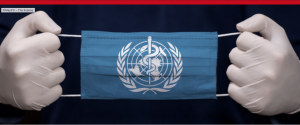Australia: The plan for future pandemics is not large-scale lockdowns but targeted, individualised surveillance, quarantines and mandates
14 min read
Due to the infrastructure being implemented under the digital ID framework in Australia, the next pandemic will not likely result in long-term large-scale lockdowns, but rather targeted surveillance, lockdowns and compliance orders.
A report funded by “philanthropic” foundations outlined the future pandemic responses in Australia, with recommendations for real-time data collection, setting up an Australian Centre for Disease Control and government decision-making through data usage. The aim is to have a well-coordinated response to future pandemics, with a focus on targeted surveillance, data sharing and compliance directives.
Additionally, Social Impact Investing through ESG scoring is shaping the narrative and agenda around how businesses deal with pandemics, with a focus on equity and inclusion.
All indications are that the future response to pandemics in Australia will involve targeted surveillance, rapid testing and compliance with vaccine mandates, all driven by technology such as digital IDs. The overall goal is to create a seamless, individualised approach to pandemic management, which could have implications for democracy and public pushback.
What is Planned When the Next Pandemic is Announced?
By Kate Mason
I came across a Facebook post where people were discussing whether there will be future pandemic lockdowns. People’s views primarily were that in the case of a full-scale lockdown, they would not comply and that the government would not try a full-scale lockdown again due to the large amount of people who protested about the government covid-19 measures in 2021-2022.
I don’t think there will be long-term large-scale lockdowns in the future. If there are, they will only be in place for a short time. I say this as the infrastructure for surveillance is being implemented under the digital ID framework – as well as other government measures, bodies and legislation introduced over the last few years – allowing for targeted surveillance, lockdowns and compliance orders.
Surveillance, targeted lockdowns and compliance orders are discussed in these excerpts with World Health Organisation (“WHO”) representatives (full video HERE) [Note: we were unable to upload the 4-minute clip included in Mason’s article, so we have embedded the video below to begin with the first part of Mason’s clip]:
Professor Mukesh Kapila, former Director of Emergencies at the WHO, states clearly that border closures and panicked strategies should not be implemented again, and that the covid measures created as many issues as they were tasked to solve. The answer is clearly targeted lockdowns for those who have a virus and those who are in contact (indicating strong surveillance measures), targeted early intervention mRNA injections (the number of people injected will expand as the virus circulates), and this links into a digital ID system.
I discuss the next advancement of Australia’s (mandatory) digital ID – TEx (as announced by Bill Shorten recently) in an interview with Reality Check Radio, and I discuss why I think lockdowns will be targeted:
The link to a more comprehensive look at the Digital Identity Trust Exchange (“TEx”) announcement is found HERE.
Fault Lines Report
The plan for Australia’s future pandemic responses were set out in an “independent” report released in October 2022, ‘Fault lines: an independent review into Australia’s response to covid-19’. The report was funded by Social Impact “Philanthropists”: John & Myriam Wylie Foundation, the Minderoo Foundation and the Paul Ramsay Foundation.
John and Myriam Wylie own the investment platform Tanarra. An investment firm with $3 billion under management. Tannara is heavily invested in surveillance technologies.
Minderoo is Andrew and Nicola Forrests’ philanthropic entity, heavily invested in Social Impact Bonds.
Paul Ramsay Foundation is a Social Impact Bond company. I specifically discuss the Paul Ramsay Foundation HERE.
On the surface, the Fault Lines report (if you didn’t read it) looked good:

The Sydney Morning Herald, 20 October 2022
The Fault Lines report asserted that the Australian government had been heavy-handed in its response to covid, and this created further societal inequity i.e. anyone who was vulnerable became more vulnerable. For example, there were serious repercussions for children’s learning, domestic violence, people’s socio-economic status and mental health etc.

Fault Lines, 20 October 2022, pg. 35

Fault Lines, 20 October 2022, pg. 6

Fault Lines, 20 October 2022, pg. 26
People who had fought against government covid overreach were celebrating the release of the Fault Lines report. But, what’s important to understand is that the harms caused by a government policy are then used to justify an even more nefarious solution, which is what the Fault Lines report proposes. I read the Fault Lines report at the time and was horrified, so I put out a video:
I want to put the Fault Lines report back on people’s radar. Specifically regarding lockdowns, what the future vision is for pandemics and how this marries into digital ID. Forewarned is forearmed.
The Fault Lines report finishes off with the vision of how they want future pandemics dealt with. The report assures us that pandemics will become more frequent and therefore there needs to be a well-oiled machine in place so disruptions are limited.
The Vision For Future Pandemic Policies
The Fault Lines report puts on the agenda:
- Real-time data on travel, health, customer spending and location. This implies a digital ID is in place.
- Harmonised systems – meaning large-scale lockdowns will be temporary, at most.
- An Australian Centre for Disease Control.
- Establish an inter-jurisdictional Public Service Centre of Excellence.
- Establish a panel of multidisciplinary experts and representatives to advise governments and the National Cabinet during health crises.
- People affected will receive immediate payments (this will be based on compliance).
- People who come or return from overseas are quarantined.
- Strong tracking, tracing, testing and quarantine methods are already in place – targeted lockdowns occur.
- Streamlined “health” messaging will be broadcast. All government agencies, private sector and non-governmental organisations (“NGOs”) in lockstep. People from multicultural backgrounds will be targeted in their homeland language.
- The system will be so seamless that individuals will be compelled to comply or … ?? This is not spelt out.
If the report is correct, when the next “pandemic” arrives it will not be a messy, noisy, ad hoc, confusing, tumultuous endeavour. It will be streamlined, meaning all aspects of the management of people will be in sync and justified through data. People will be managed with technocratic efficiency. This has implications for democracy and public pushback.
The ACDCP referred to below is the Australian Centre for Disease Control and Prevention.
The National Cabinet was formed in 2020 for the Government’s Covid response. They have not disbanded and address a number of portfolios, as found HERE.


Tracking and Tracing of People
My bet is that when the next pandemic hits Australia, the Government’s recently announced Trust Exchange (TEx) digital ID system will become compulsory to purchase goods, services, and to be able to work and access government services.

Fault Lines, 20 October 2022, pg. 26
Mass scale lockdowns do not need to occur if you have contact tracing, ready-to-go vaccines and clear communication strategies in place:

Fault Lines, 20 October 2022, pg. 28
Fault Lines Report Recommendations
Recommendation 1 – Strengthen Crisis Preparation, Planning and Testing
Firstly, the report calls for widening what can be defined as a pandemic:

Fault Lines, 20 October 2022, pg. 45
The Government’s approach to the future pandemic must be thoroughly practised prior, involving many stakeholders – government, business, police, NGOs etc:

Fault Lines, 20 October 2022, pg. 45

Fault Lines, 20 October 2022, pg. 45
Supply chains must be involved in the plans, this includes medical equipment but would also include food. Hence, the tracking and tracing of our food systems which is being implemented (climate change and sustainability are other justifications used for food tracing):

Fault Lines, 20 October 2022, pg. 46
Ministers from different States and Territories will be in lockstep:

Fault Lines, 20 October 2022, pg. 46
Emergency legislative frameworks need to be ironed out:

Fault Lines, 20 October 2022, pg. 46
The Victorian legislation referred to is the controversial Public Health and Wellbeing Amendment (Pandemic Management) Bill 2021:

Targeted lockdowns will occur, and employers will have legal obligations to fulfil regarding vaccine mandates, testing and other compliance directives:

Fault Lines, 20 October 2022, pg. 46
Recommendation 2 – Establish an Expert Body and Trusted Voice on Public Health
Create an Australian Centre for Disease Control and Prevention:

Fault Lines, 20 October 2022, pg. 49
The Centre for Disease Control and Prevention coordinates the surveillance, tracking, data collation and analysis:

Fault Lines, 20 October 2022, pg. 51

Fault Lines, 20 October 2022, pg. 51
The ACDCP links into States and Territories:

Fault Lines, 20 October 2022, pg. 51
The ACDCP advises the AHPPC:

Fault Lines, 20 October 2022, pg. 51
The AHPPC is the Chief Medical Officer and the States and Territories Chief Health Officers:
The Commonwealth Scientific and Industrial Research Organisation (“CSIRO”) is mentioned:

Fault Lines, 20 October 2022, pg. 51
HERE is the CSIRO ‘Strengthening Australia’s Pandemic Preparedness’, with a focus on vaccines and testing:

The Government is currently in the process of establishing an Australian Centre for Disease Control:

Recommendation 3- Improve Government Decision-Making Through Broader Advice and Greater Transparency
A panel of non-medical experts will be chosen to inform the Government on pandemic policies. The issue with this is that the chosen panellists will not question the overall pandemic narrative and medical interventions:

Fault Lines, 20 October 2022, pg. 53

Fault Lines, 20 October 2022, pg. 54
Recommendation 4 – Finance Public Service Collaboration, Capability and Communication

Fault Lines, 20 October 2022, pg. 59

Fault Lines, 20 October 2022, pg. 60
The Australian Public Sector is in the process of being reformed:


What this means is that the Government’s role is one of data collection, curation and implementation of solutions based on the data. This links inextricably into smart technology or cities and how people are monitored through digitalised tools:

World Economic Forum, February 2017

World Economic Forum, February 2017, pg. 3 and 7

World Economic Forum, February 2017, pg. 8
Targeted messaging – the government faced issues with an inability to capture culturally and linguistically diverse (“CALD”) communities within Australia. Instead of listening to the Australian government, they were listening to in language commentary from their home countries. According to Fault Lines, this led to the CALD communities being “misinformed” as well as being targeted by nefarious actors spreading “misinformation.” The government must correct this:

Fault Lines, 20 October 2022, pg. 62

Fault Lines, 20 October 2022, pg. 62
After all, it doesn’t look democratic when the Government targets highly multicultural areas by sending in the army to enforce covid policies:


Yahoo News, 5 August 2021
The areas in Sydney which were targeted as “areas for concern” during 2022 were all highly multicultural. People who lived in these areas were unable to leave their local government area:

Recommendation 5 – Modernise How Governments Use Data
Data will be made more freely available, under the pretence of “strengthening data.” Data on people is to be shared and must be the default position:

Fault Lines, 20 October 2022, pg. 65

Fault Lines, 20 October 2022, pg. 65

Fault Lines, 20 October 2022, pg. 65
Regarding the Google and Apple partnership with the Australian government, the Application Programme Interface uses Bluetooth to create a log of other devices that come into close range:

Data sharing is the default position:

Fault Lines, 20 October 2022, pg. 65
The Data Availability and Transparency Act 2022 allows for public-sector data sharing that permits Australian Government (Commonwealth) bodies to share their data with other Commonwealth bodies, Australian state or territory government bodies, or Australian universities. Found HERE.
Data sharing was problematic during covid once people crossed over State and Territory boundaries. This must be streamlined:

The government is currently in the process of overhauling Australia’s Privacy Act:

Australian Government, 2023


As stated above the Government agrees that under rolling emergency declarations – health, climate, biosecurity, terrorism, cybersecurity – people’s rights to privacy protections are waived. The public’s right to give consent to their data being shared is waived for research that is in the “public interest.”
Recommendation 6 – An Independent Office of the Evaluator General

Fault Lines, 20 October 2022, pg. 70

Fault Lines, 20 October 2022, pg. 72
The government is in the process of creating an Australian Centre for Evaluation under the guise of “wellbeing”:

25 May 2023
And:

What This Means
The government, since 2020, has been busy passing legislation, digital surveillance tools and overarching bodies to be able to implement targeted surveillance, data sharing, contract tracing and Australia-wide coordinated systems. This will allow for seamless individualised approaches to testing, quarantine and vaccine mandates for the next upcoming pandemic which hits Australian shores.
I believe the next pandemic approach will be similar to the biosecurity responses to pests, two examples are:
1. In 2022-2023 the NSW government started killing bees due to finding Varroa at a Sentinel hive (I researched and campaigned intensely on the government measures and the whole thing stunk to high heaven). It started with small red zones which was a 10 km zone drawn around anywhere a varroa mite was found, everyone in the red zone had to kill their bees. The red zones kept growing until 40,000,000 bees were killed, according to the DPI (however this number seems low). In the map below, the red zones are where bees are killed and purple zones are where bees are monitored. This is an early map, many more areas were added, but it shows the approach.

2. The Queensland government is currently baiting (multiple times the same area) and showering chemicals from planes and drones over parts of Queensland to kill fire ants. The zone where this is occurring keeps growing (this is an old map but shows the approach):

In my view, the future approach to pandemics (Fault Lines report states they want the definition of pandemics to broaden) will look something like this:
- When someone is found to have a virus their movements, during an identified contagious time, will be accessed and all close contacts – sitting near someone on a train, for example – will be notified that they need to quarantine.
- Testing will be enforced on those in quarantine.
- A readily available mRNA injection will be delivered.
- The surrounding community will be under suveillance and monitored more closely.
- The virus, will of course spread, so the process will roll on incrementally.
- Those who are in initial quarantine will be injected and released if they comply.
- Those who don’t comply will not be able to access emergency payments or be released from house arrest (details will become clearer on this over time).
- Outside movement, whilst under quarantine orders, will be made difficult through digital surveillance.
There won’t be mass lockdowns, where too many of us are shut down and therefore start to band together and say “enough”! This is very important to consider in how the people can stand together in future years.
Just a little on Impact Markets
It’s relevant that the Fault Lines report was funded by Social Impact investors. Social Impact Investing links into environmental, social, and governance (“ESG”) scoring. Dr Julianne Romanello states that the ESG-Social Impact Investing framework “entail[s] the power to shape and to control individual minds and to engineer society so to further benefit those who already lord over the people through finance and who have demonstrated no compunction about their use of deception and division.”
Minderoo and the Paul Ramsay Foundation are both members of the Global Impact Investing Network (“GIIN”). GIIN is the “global champion of impact investing, dedicated to increasing its scale and effectiveness around the world.”
The investments and returns will be funnelled through the ESG framework – environmental, social and governance. Only companies that have a good ESG score will be able to survive. This means companies have to get on board the health and climate change mitigation agenda; the coerced genetically modified organisms, injections, synthetic biology, synthetic food, carbon tracking and tracing, genetically engineered “Climate Smart” seeds and plants, “renewables,” mass critical mineral mining, Managed Retreat, solar radiation modification etc, social giving (supporting the Social Impact Bond wellbeing-surveillance-interventions turning the welfare system into a for-profit market) and governance (how well is the company “looking after” people during pandemics – as one example) systems.
ESG and Social Impact investing is a key mechanism to create the global, centralised control infrastructure, which will be central to the One Health model and to contain everyone within the UN 17SDGs.
As found here:


And HERE, making very clear the way businesses deal with pandemics will determine whether they succeed or fail:



And here:

Put bluntly, ESG is the capture of the business world and finances into funding agendas. The United Nations Agenda 2030 to be exact.

The narrative states that covid created a fairer world where equity and inclusion – which means everyone vaccinated, and giving people money so they didn’t starve and become homeless whilst under house arrest i.e. lockdowns – trumped looking after the economy. In this new world order, where under rolling threats “no one is left behind,” those of us who would like them to leave us the hell alone have some serious upcoming challenges.
Oh, and in the equity and inclusion “Values Before Value” fairy dust spun over covid house arrests, coerced injections, police brutality, suspension of human rights and heavy surveillance they never factor in this reality:

Business Insider, 7 April 2021
The game is rigged!

Source: https://expose-news.com/2024/09/01/australia-the-plan-for-future-pandemics/







